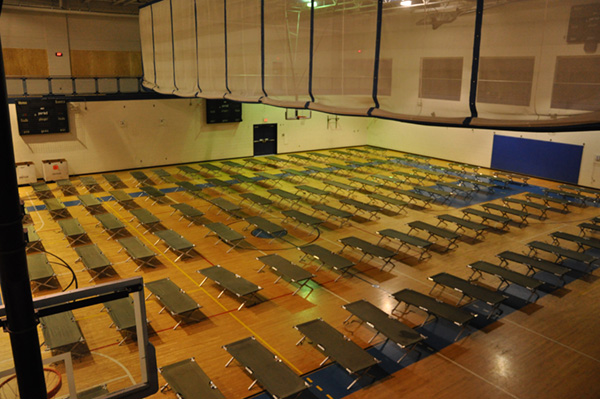Sheltering
California takes an integrated approach to sheltering operations. Shelters should be physically and programmatically accessible in order to meet the needs of everyone in the community, including individuals with access and functional needs. In rare cases, individuals may arrive at shelters with complex medical needs and may need transportation to a higher level of care. However, that is the exception, not the rule, as even acute medical needs can and should be addressed at General Population Shelters.
Shelters need to be physically and programmatically accessible and equipped with the assets and resources necessary to ensure the needs of individuals with access and functional needs are met in a timely, inclusive, and dignified manner. This does not happen unless sheltering plans are developed in close partnership with the whole community.
It is critically important to ensure survivors are not separated from their support systems (e.g. care provider, service animal, etc.).
It is important to remember that a shelter is not a hotel. For detailed guidance on sheltering, visit the Sheltering section of the AFN Library.
Sheltering Facilities
Facilities designated as shelters should comply with the requirements established under the Americans with Disabilities Act (ADA). Facilities that do not comply with the ADA, such as older school buildings and religious establishments, can often be made compliant or useable by obtaining portable units to increase accessibility (e.g. ADA-compliant porta potties, showers, etc.). Many accessible resources can be located using the OAFN California Access and Functional Needs Web Map.
When identifying shelter locations, consider the following:
- Does the facility comply with the ADA Checklist for Emergency Shelters?
- Can the location be made accessible by bringing in additional resources? Highlight accessible shelters in press conferences, news broadcasts, press releases, etc.
- Communication access resources (e.g., sign language interpreters, language translation services, braille/large print materials, readers, etc.) need to be available in-person or virtually at all shelter locations.

Sheltering Management Considerations
Shelters should be managed in a manner that considers, addresses, and meets the access and functional needs of all clients, evacuees, and survivors. To ensure a successful, inclusive sheltering operation, it is vital for local jurisdictions to engage in a continuous dialogue with their whole community stakeholders and remember that no two persons are the same.
Below are some important considerations:
- Self-determination is an essential right.
- A variety of accessible cots should be available including raised cots, bariatric cots and cots with side rails.
- Shelter staff should be aware, patient, and creative.
- Give individuals with mobility-related disabilities the option of going to the front of lines.
- Shelter staff should know how to contact accessible transportation providers, American Sign Language interpreters, local Independent Living Centers, and mental health providers.
Assessments/Services
The Functional Assessment Service Team (FAST) assists individuals with disabilities and others with access and functional needs (AFN) in general population shelter settings. FAST members are deployed when a request is made to the Emergency Operation Center (EOC) and stay until services are no longer needed.
FAST members have an in-depth knowledge of the populations they serve, support services and resources including housing programs, benefit programs, and disaster aid programs. FAST members work side-by-side in support of shelter personnel and emergency response workers to assist in meeting the essential functional needs of survivors in shelter environments.
In addition to assessing individual needs, FAST members evaluate the essential functional needs that can be supported within a given shelter. FAST members, comprised of trained government employees, representatives from community-based organizations (CBOs), and non-governmental organizations (NGO), can deploy to shelters before, during, and after disasters.
More information on FAST can be found on the CDSS FAST web page.
Equipment/Resources
It is recommended that agreements be established and/or the following equipment/resources be obtained to ensure they are available at general population shelters. Equipment/resources include but are not limited to:
- Accessible cots-recommended criteria: Height – 17″-19” (without mattress), width – minimum 27”, weight capacity – 350+ pounds. Flexible head and feet positions. Rails, if any, must be positioned, or moveable, in such a way to allow for wheelchair access.
- Toilet chairs
- Raised toilet seats
- Shower chairs
- Wheelchairs (multiple sizes)
- Wheelchair battery chargers
- Walkers
- Walking canes
- White canes for people who are blind (46”-60”)
- Crutches
- TTY equipment
- Wireless communication devices
- Visual translators (picture, symbols & words)
- Magnifiers
- Hearing aids (batteries)
- Height adjustable tables
Transportation
To ensure individuals with access and functional needs have accessible transportation resources available to meet their needs (e.g. getting to/from work, medical appointments, etc.) while at shelters, jurisdictions should develop MOU agreements with local vendors in advance of disasters.

